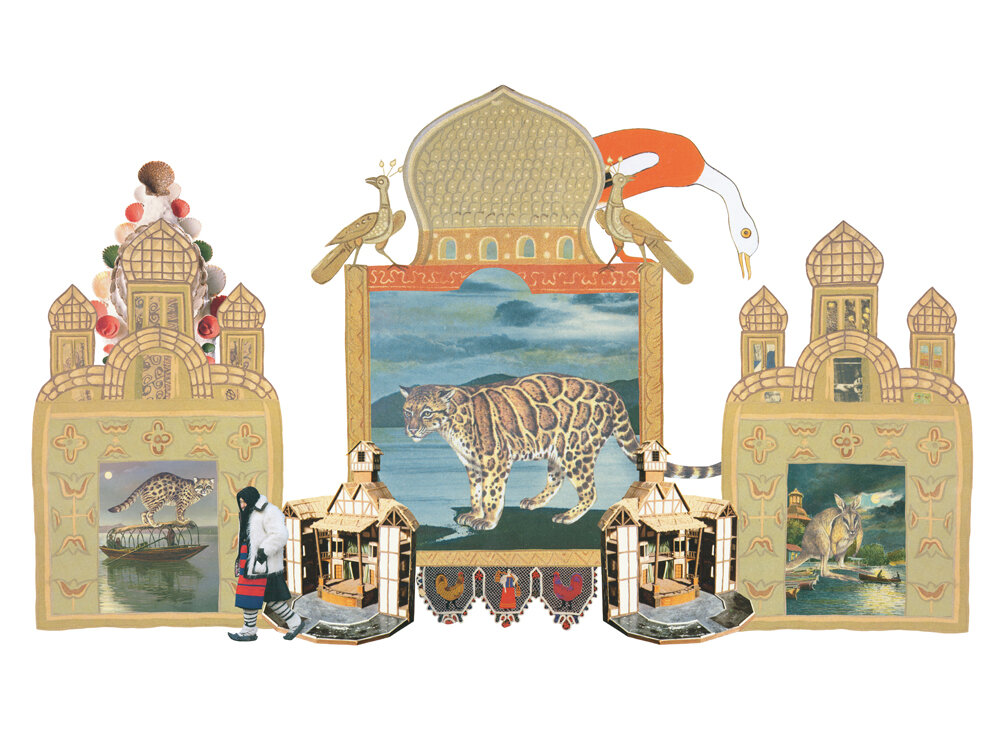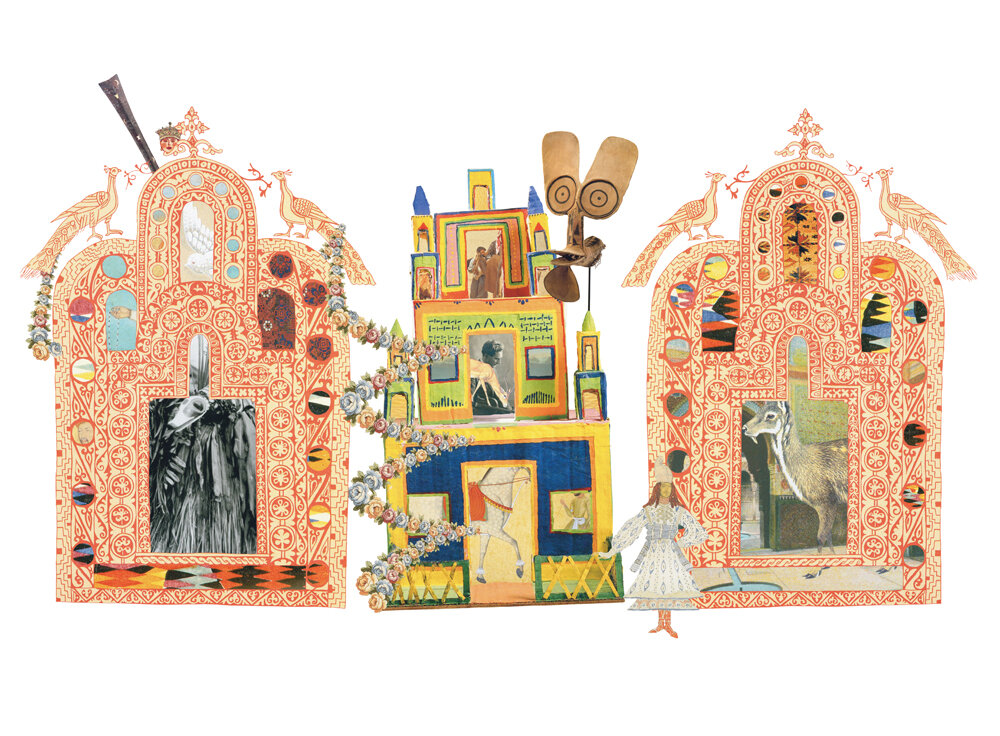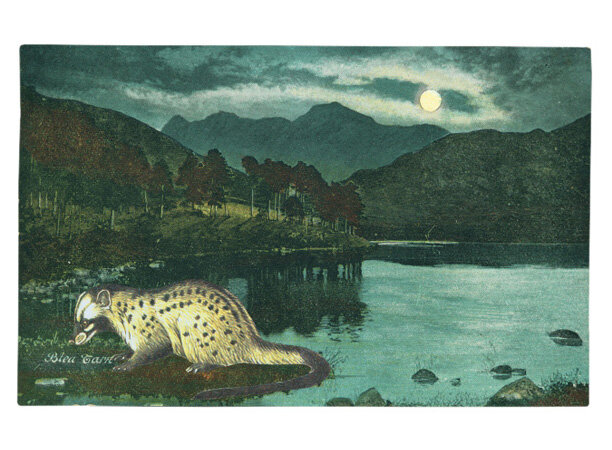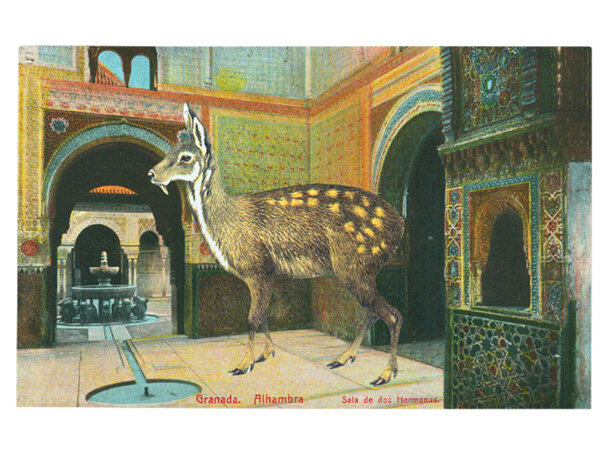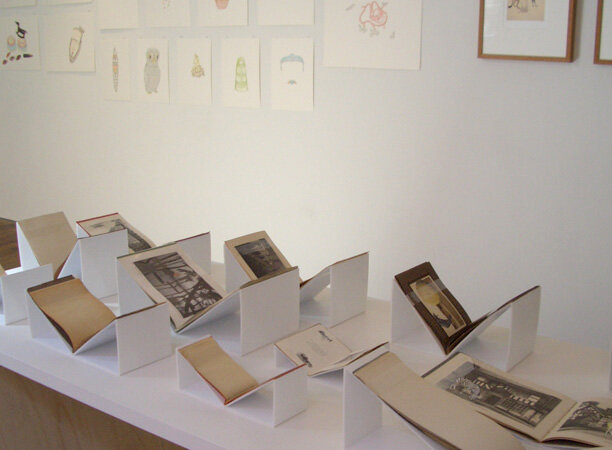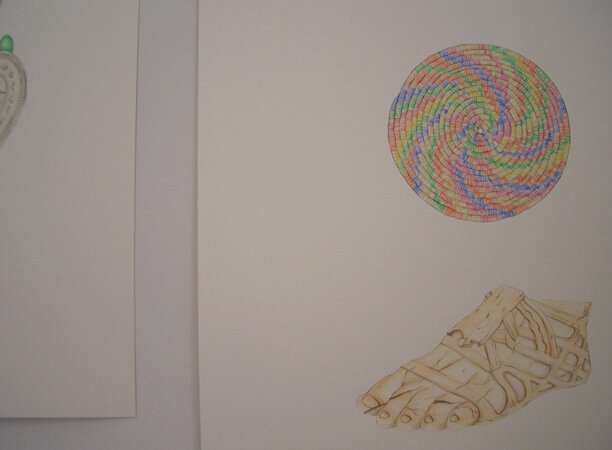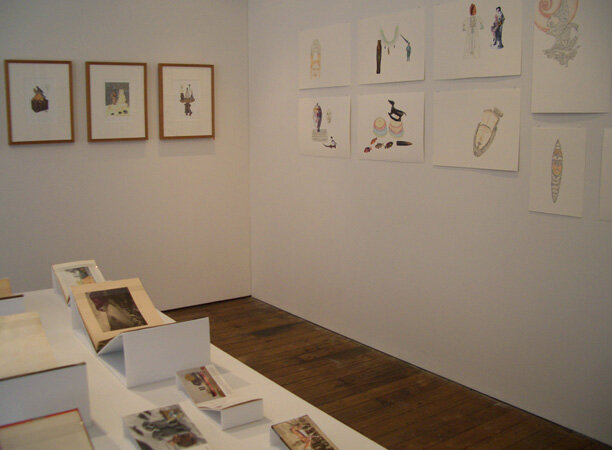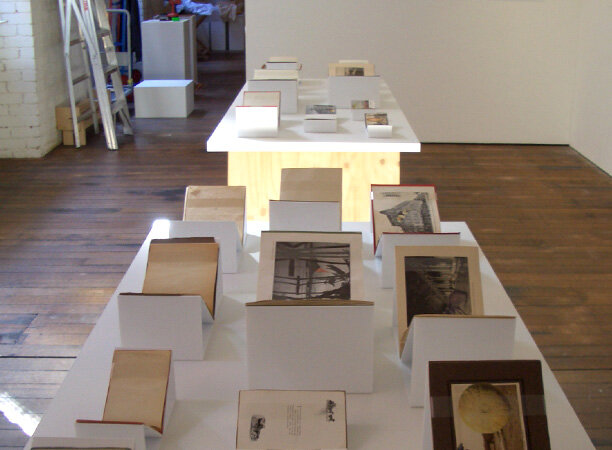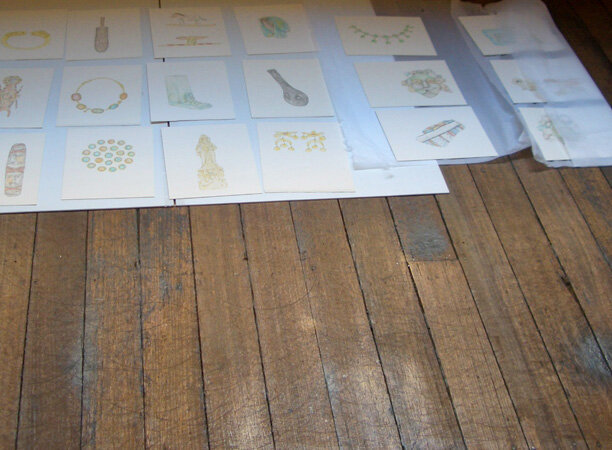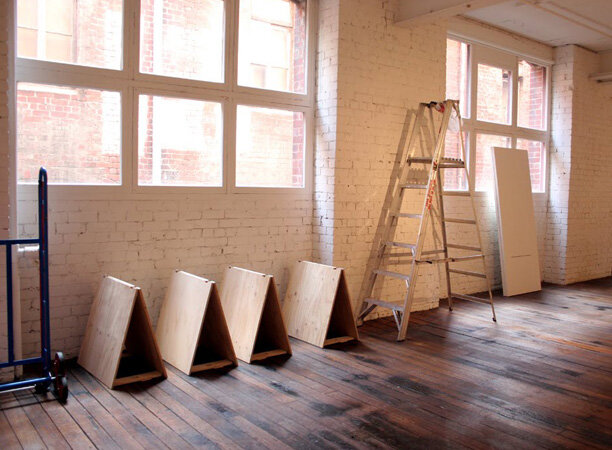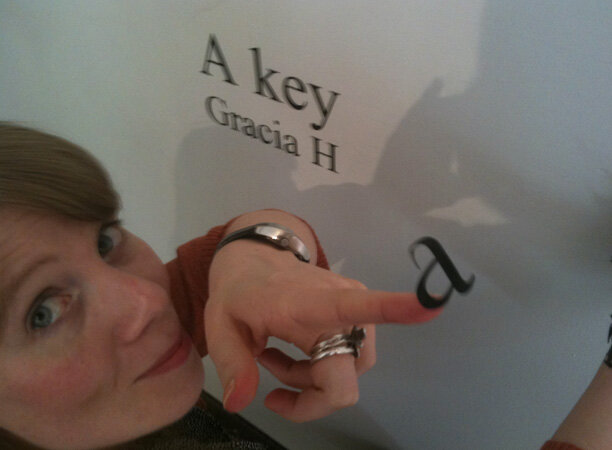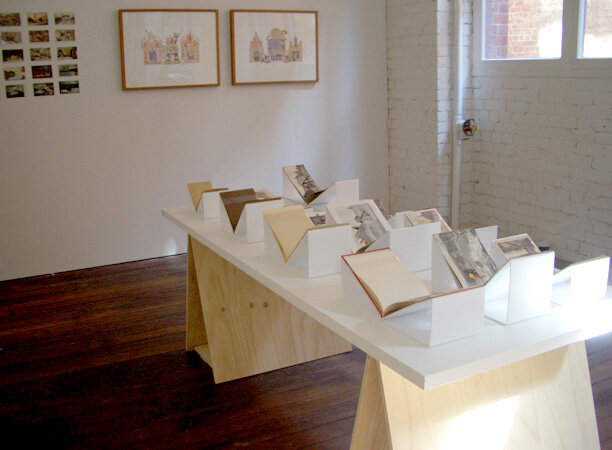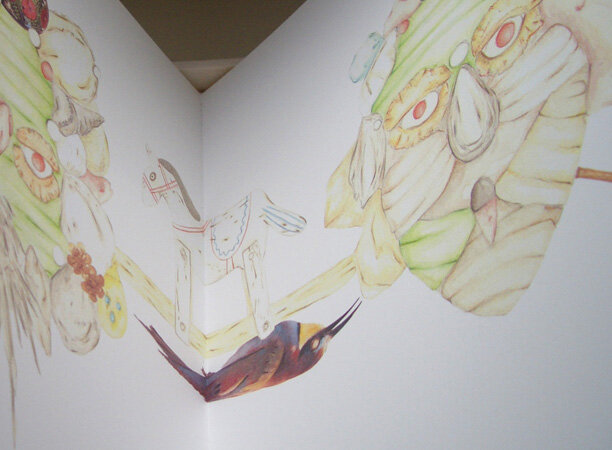A KEY TO HELP MAKE YOUR OWN WORLD VISIBLE
An amalgam of sentiment and prose pulled from the pages of Hermann Hesse’s novel Der Steppenwolf (1927).
Gracia Haby & Louise Jennison
A key to help make your own world visible
2009
78 drawings and 55 collages
Exhibited
Friday 23rd of October – Saturday 28th of November, 2009
Craft Victoria, 31 Flinders Lane, Melbourne
Guidance for those curious
A key to help make your own world visible list of works (6 page PDF)
A key to help make your own world visible is an amalgam of sentiment and prose pulled from the pages of Hermann Hesse's novel Der Steppenwolf (1927).
Spoken in warm voice by Pablo to Harry: ‘I can throw open to you no picture-gallery but your own soul. All I can give you is the opportunity, the impulse, the key. I help you to make your own world visible. That is all.’ [1]
From such we took impulse and created a series of other worlds that lie hidden, other interior worlds viewed with twin ‘gleam of pain and beauty that comes from things past’. [2]
Often our work, be that created individually or a piece worked on collaboratively, is dotted with fragmented keepsakes, and that is especially true of the work we have created for this exhibition. A sense of nostalgia is never far from frame, but ‘nostalgia is not always about the past; it can be retrospective but also prospective’. [3] It can cast also a sideways glance and be likened to unrequited love: ideal, unreciprocated and satisfying. In so far as memory is concerned, it should not be relied upon.
Nostalgia comes as a word from ‘nostos’—return home, and ‘algia’—longing (or pain). Its roots, in word, are Greek, and it ‘seduces rather than convinces’ [4], something which greatly appeals to us both for we like to work in riddles and puzzles, and what could be more puzzling than something as hard to pin into place as seduction?
The inner landscape and the greater literal world, the geography we map charts longing, and fragility is revealed along the way. But be forewarned, it is oft a pathway littered with red herrings. Our keepsakes, these objects gathered, perhaps they are not all they appear at first cursory glance. Perhaps these objects take, as Jean Cocteau once mused, ‘advantage of our habit of believing them to be immobile.’ [5]
Shell masks from Manfredo Settala’s (1600–1680) own cabinet of curiosities, a 16th century German automation of Neptune seated upon a tortoise, and an owl in gold, enamel, agate and diamonds made in Dresden before 1718 have been both collected and drawn, and appear now alongside carvings displayed during yam harvest rituals in Papua New Guinea from the Masco Collection of Oceanic Art. Calling to mind a wonder cabinet of curious, they serve to bring together ‘liminal objects (suspended between art and nature, death and life) ….investing them with new value, new power, new meaning.’ [6] Yes, for you, we have, with brush and watercolour pigment, and scissors and paper as our primary tools, created both collections of curious and other worlds.
As you wander, let the words of the poet Joseph Brodsky guide you: ‘you cannot step twice on the same asphalt.’ [7]
Travel well,
Gracia & Louise
[1.] Hermann Hess, Der Steppenwolf (Australia: Penguin Group, 2009), page 204.
[2.] Ibid., page 186.
[3.] Svetlana Boym, The Future of Nostalgia (New York: Basic Books, 2001), xvi.
[4.] Ibid., page 13.
[5.] Jean Cocteau, Beauty and the Beast: Diary of a Film (New York: Dover Publications), page 101.
[6.] Patrick Mauries, Cabinets of Curiosities (London: Thames & Hudson, 2002) page 119.
[7.] Solomon Volkov, Conversations with Joseph Brodsky (New York: The Free Press, 1988), page 286.
﹏
RELATED LINKS,
FEATURED ON SUNDAY ARTS, ABC TELEVISION, 18TH OF OCTOBER, 2009
FOR THE EXHIBITION'S DURATION, WE GUEST POSTED ON CLOG, CRAFT VICTORIA'S BLOG
RELATED POSTS,
THEN AND NOW, NOW AND THEN
WITH INK ON MY PAWS
THE DAY PASSED WITHOUT MISHAP
SAILING AWAY IN PEA GREEN AND BEAUTIFUL BOAT
ALMOST AT AN END
TO LEAF THROUGH
LOOKING INTO A MIRROR
UP SHE GOES, DOWN SHE GOES
HOP, SKIP AND A JUMP
A NEW ZINE TO ACCOMPANY AN EXHIBITION
SO MUCH TO SHOW YOU
A THING INSTALLED
LOOK BEHIND YOU
WITH WISTFUL AFFECTION
THE BEAUTY ASLEEP IN THE WOOD
PART OF THE WEEKEND
The Melbourne Art Review
Emma Kirsopp
12th of November, 2009
On now in Gallery 2 of Craft Victoria is a collaboration between artists Gracia Haby and Louise Jennison that presents a wunderkammer of paintings, prints, collage, postcards and artists’ books.
A show that centres on themes of nostalgia, love and introspection, the title comes from words in Hermann Hesse’s 1927 novel Der Steppenwolf and the artists have created artefacts based on the story’s sense of longing and displacement. The result is an alternate universe of fantastic curiosities, of pain and dreams made flesh.
The ideas come together most successfully in the lithographs which take the best elements of the collages and watercolours and reflects most succinctly the theory behind the show. The combined skill of the artists and the quality of the work is capable of supporting the narrative concept, which after reading the exhibition statement would have been no easy feat.
A Key to Help Make Your Own World Visible is a superb and intriguing exhibition that works well within the gallery space.
Printmaking
Dylan Rainforth
The Arts, The Age, 23rd of October, 2009
Magic forests, bizarre circus folk…. The interior worlds of Hermann Hesse’s Steppenwolf have inspired a collection of beautiful lithographic works by collaborative duo Gracia Haby and Louise Jennison. The pair have worked together for over a decade since graduating from RMIT. Titled A Key to Help Make Your Own World Visible from a quote in Hesse’s novel, the exhibition is a continuation of the pair's work in building miniature worlds in artists’ books and on paper.
Current Forecast: Mid Week Art Fix
Michi Girl
22nd of October, 2009
Gracia and Louise painted the bird picture above my desk. Not only is it beautiful, it’s also sentimental — it was the first piece of art I bought for my office. Nothing distracts the eye from a cheap Ikea table than a beautiful piece of art, especially one from these talented girls. Their show is opening tomorrow night at Craft Victoria. See you there. I’ll be the one with the big blue Ikea bag.
Inside Out
Vanessa Colyer Tay
Interview for Inside Out magazine’s blog
28th of September, 2009
The online world is a great tool in connecting us with creatives, especially when it comes to these two artists: Gracia Haby and Louise Jennison. They like to tinker late at night and use paper as their primary medium, making limited edition artists' books, lithographic offset prints and zines.
They are also responsible for Hammer & Daisy, a handmade, one-of-a-kind range that includes postcards, journals, notebooks and soft toys. You can bag Gracia and Louise's zines, artist proofs, books and notebooks at their online store.
I describe the pair as crafty, visual storytellers; Gracia and Louise’s creations are soulful, childlike, soft and nurturing. Looking at their work inspires and makes me feel a little dreamy. Fuelled with my new-found awe for these artists, I wanted to discover a little more. The girls generously answered a few questions — see below for insight into these creative souls.
What are the inspirations for your up and coming exhibition?
A Key to Help Make Your Own World Visible, the title of our forthcoming exhibition in gallery two of Craft Victoria, is an amalgam of sentiment and prose drawn from Hermann Hesse’s novel of 1927, Der Steppenwolf.
Spoken in warm voice by Pablo to Harry: ‘I can throw open to you no picture-gallery but your own soul. All I can give you is the opportunity, the impulse, the key. I help you to make your own world visible. That is all.’
From such we took impulse and set to creating a series of other worlds that lie hidden, other interior worlds viewed with twin ‘gleam of pain and beauty that comes from things past’. (Hermann Hess, Der Steppenwolf) If you like, it served, and continues to serve, as an ever-flexible springboard from which we’ve been launching ourselves from for some time now.
We have also looked to the seductive power of nostalgia. Nostalgia greatly appeals to us both for it is somewhat of a riddle not to be trusted in so far as memory is concerned. The inner landscape and the greater literal world, the geography we map charts longing, and fragility is revealed along the way, we hope. But be forewarned, it is oft a pathway littered with red herrings. Our keepsakes, these objects gathered, perhaps they are not all they appear at first cursory glance. Perhaps these objects take, as Jean Cocteau mused, ‘advantage of our habit of believing them to be immobile.’ (Jean Cocteau, Beauty and the Beast: Diary of a Film)
This, in a loosely formed nutshell, is the story behind our forthcoming exhibition.
How long has it been in the making?
Our work for this exhibition has been in the making for some time now and is, as you'd expect, gathering fierce momentum as the date for installation draws ever nearer. The works exhibited will be the result of roughly a year, or more, in some cases, and we are being driven slightly mad as anticipation and nerves mount.
Between the two of you, who is better at what?
Having worked collaboratively for a little over ten years now, we wear our collaboration like a second skin. As Ramona and Rebecca referred to us in their recent book I Make Stuff, ‘perhaps it is easier to think of them as a left and right hand of the same body.’ (Ramona Barry & Rebecca Jobson, I Make Stuff)
That one favours watercolour pigment to scissors is of no surprise, we’re sure. Perhaps we could also add, one of us is more comfortable working within the realm with colour, the other with framing a composition. One favours the spoken word, the other the written.
What's the best thing about working together?
Sharing the combined weight of ridiculous doubtfulness and maddening frustration is one of the best things about working side by side and on the one image or page. Yes, a load shared is lighter, this much is true It is also a reassuring path to tread. But it is challenging, too. It helps keep one motivated. It is endlessly inspiring. And it is comfortable in the best possible sense. Seems it is every little thing to us.
...and the worst?
Two peas in a pod, sometimes, it has to be said, we lack the voice of reason, someone to firmly place both feet on the earth, grounded once more to reality after a bout of fancy or self-doubt. Sometimes such similarity of working, and thinking, too, has its downfall.
A well-known joy of collaboration is that it yields fruit not possible without the other, that an image can be made that would have been possible by no other means; for such a reward, who wouldn’t risk a little madness?
You say you tinker late at night, how late are we talking? Do you find the night particularly inspiring or is it a logistical matter?
Whilst one of us is more of a natural night owl than the other, we rather fell into this pattern of working at night due to logistical reasons referenced. It is quiet in the house, it is quiet in the street outside our house, and the body feels ready for a little stillness after the day. It feels as though you are less aware of the time passing as you sit and either draw or cut out future collage pieces. Daytime chores don't nag for attention either.
Sometimes it can be more than logistical reasons that find us working late. It is an inspiring time to set the mind exploring or to harness the idyll dreams from the day.
Sometimes we work into the early hours of the morning though this is not nearly as often as we'd have you believe.
In the coming show what are your favourite pieces and why?
We are having a great deal of fun putting together the different works for this show. There will be watercolours, there will be artists' books; there will be framed pieces, prints on the wall. Neither of us is yet sure what piece or pieces we will be particularly attached to. Perhaps once we see it installed in the calm white of the gallery space. Working from our home-based studio, most of our work, once dry, is quickly whisked away to be stored or under press.
PAPER, PRINTS AND ANIMALS
Kinki magazine
6th of April, 2010
Too much excitement for a single day
(German to English rough text translation)
As the name suggests, Gracia & Louise is a collaboration between the two artists Gracia Haby and Louise Jennison. Together they create artists’ books, art prints, postcards and drawings — their art focuses on working with different materials on paper.
The two Australians have been working together for over ten years. They inspire each other, complement each other technically and, last but not least, harmonise perfectly in their very own fairytale world in which flora, fauna and mystical figures from all over the world merge into colourful, detailed images from another world. Gracia Haby and Louise Jennison are particularly fond of collages, the possibilities are endless, just as you can endlessly lose yourself in the beautiful world of unique images full of beauty, surprise, sadness and humour.
When put together, the little treasures look like a midsummer night's dream from a fairytale world in which wild thoughts take shape and there are no limits to the unbridled imagination.
Gracia and Louise both also run a blog, in which they present their own art, but also other small, fine discoveries, taking the reader into a colourful world.
